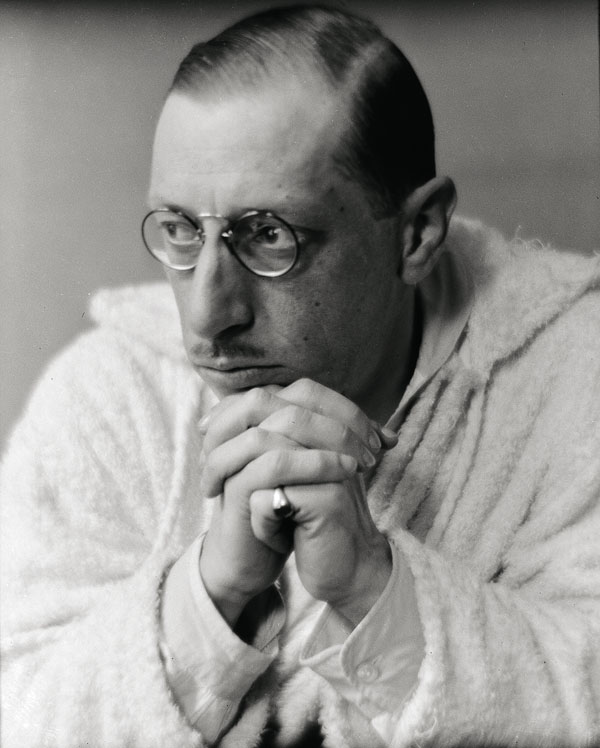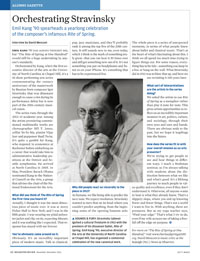Alumni Gazette
 SOUNDS & FURY: Stravinsky (above) ignited a cultural firestorm in 1913 with the premiere of his dissonant ballet, Rite of Spring. Emil Kang ’90, executive director of the arts at the University of North Carolina at Chapel Hill, has organized a centennial celebration of the now canonical work. (Photo: Getty Images)
SOUNDS & FURY: Stravinsky (above) ignited a cultural firestorm in 1913 with the premiere of his dissonant ballet, Rite of Spring. Emil Kang ’90, executive director of the arts at the University of North Carolina at Chapel Hill, has organized a centennial celebration of the now canonical work. (Photo: Getty Images)Emil Kang ’90 has always thought big, but “The Rite of Spring at One Hundred” would still be a huge undertaking by anyone’s standards.
Orchestrated by Kang, who’s the first executive director of the arts at the University of North Carolina at Chapel Hill, it’s a 15-show performing arts series commemorating the century anniversary of the masterwork by Russian-born composer Igor Stravinsky that was dissonant enough to cause a riot during its performance debut but is now part of the 20th-century musical canon.
The series runs through the 2012–13 academic year. Among the artists premiering commissioned multimedia works are choreographer Bill T. Jones, cellist Yo-Yo Ma, pianist Vijay Iyer and puppeteer Basil Twist. It’s quite a gambit for Kang, who majored in economics at Rochester before embarking on a career that would take him to administrative leadership positions at the Detroit and Seattle symphonies. He arrived at North Carolina in 2005. In May, President Barack Obama nominated Kang to the National Council on the Arts, a group that advises the chair of the National Endowment for the Arts.
What did you think of The Rite of Spring the first time you heard it?
Actually, I thought it was the most obnoxious piece of music ever. It was at Avery Fisher Hall in New York, and I was in the fifth grade. I was wearing my plaid polyester jacket and clip-on tie, expecting Mozart, and it was nothing like I expected. That response has stayed with me forever.
You’ve obviously come around on it.
Obviously. It’s an incredibly important piece of modern music. Talk to classical, pop, jazz musicians, and they’ll probably rank it among the top five of the 20th century. It still sounds new to me, even today, which I think is the mark of something truly great—that you can hear it 20 times over and still get something new out of it. It’s not something you put on headphones and listen to on your iPhone. It’s something that has to be experienced live.
Why did people react so viscerally to the piece in 1913?
As humans, we like being able to predict the next note. We expect resolution. Stravinsky wanted to turn that on its head where you couldn’t predict anything, from the beginning notes of the opening bassoon solo. The whole piece is a series of unexpected moments, in terms of what people knew about ballet and classical music. That’s at the heart of what’s fascinating about this. I think we all spend too much time trying to figure things out. For some reason, everything has to be tidy—something you keep in a box or hang on the wall. What Stravinsky did in 1913 was to blow that up, and here we are revisiting it 100 years later.
What sort of interpretations are the artists in the series doing?
We asked the artists to use Rite of Spring as a metaphor rather than play it note for note. This gives artists opportunities to reflect on an incredibly important moment in art, politics, culture, and sociology, through their own eyes and ears and hands. There are obvious nods to the past, but we hope it leapfrogs into the future.
How does the series fit in with your overall mission as an arts presenter?
We’re trying to get people to see and hear things in different ways. I teach a freshman seminar, so I’m always talking with students about the distinction between what we like and what’s good. It’s a lifelong journey to teach people to value quality and excellence, even if they don’t understand it. Otherwise, all anyone wants to hear is what they already know. That’s a slippery slope, where you end up knowing fewer and fewer things. That’s not a world I want to live in. With anything, there are pressures. But as my yoga teacher says, “Find your edge.” That’s what I try to do, even if my wife accuses me of taking a free-fall off the edge on purpose.
For more on “The Rite of Spring at One Hundred,” visit www.theriteofspringat100.org. David Menconi is music critic at the Raleigh (N.C.) News & Observer.

